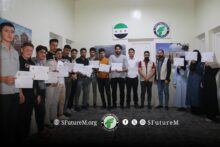
Before the outbreak of the armed conflict between the Syrian people and the oppressive Syrian regime, the country enjoyed a relatively advanced healthcare system, with five operating medical colleges, a national healthcare plan, and 37 medical libraries. According to the World Health Organization, the life expectancy of a Syrian citizen was 75.7 years in 2012, a significant increase from the average of 56 years recorded in 1970.
After the war, the health situation in Syria significantly deteriorated due to multiple concurrent crises and challenges, including ongoing insecurity, the COVID-19 pandemic, social and economic crises. These war and military attacks and the continuing violence, which blatantly violate the Geneva Convention, have almost completely destroyed the modern healthcare system in Syria, established before the war.
According to some statistics, 12.2 million people in Syria needed health assistance in 2022, including 4.4 million displaced persons, 1.33 million children under five years of age (including 503,000 expected births), and 3.38 million women of reproductive age (15-49). The healthcare infrastructure has been damaged and requires substantial resources for rehabilitation.
Health Reality:
Syrians in areas outside the control of the Syrian regime have attempted to rebuild the health sector, seeking Arab and international funding. However, in the areas of Idlib, northern Aleppo, northern Raqqa, and Hasakah, with a population of 4.4 million, there are only about 3,400 hospital beds, averaging one bed per 1,000 people. The global average bed coverage per population, according to the latest World Bank statistics, is 2.9 beds per thousand people, indicating a severe shortage of health facilities.
There is also a significant shortage of doctors in these areas, estimated at only 1,200 doctors. In Idlib province in northwest Syria, home to about 2.8 million people, there are 56 hospitals, 2,000 beds, 235 operating rooms, 237 intensive care units, and 1,500 doctors.
The areas of Hasakah and Raqqa urgently need intervention to address the severe shortage in health services. In the region between Tel Abyad and Ras al-Ain, there is only one public hospital with 18 beds, 3 operating rooms, 5 intensive care rooms, and just 18 doctors.
The Syrian Response Coordinators team previously called in a statement for donor agencies to resume support for medical facilities that have ceased operations, warning of the catastrophic consequences of stopping support for the medical sector in northwest Syria.
Under the difficult conditions in Syria, people are trying to adapt to the state of war, destroyed infrastructure, and lack of essential services. The Syrian healthcare system suffers from a severe shortage of resources, with the system unable to respond to the increasing needs and gaps in the northeast of the country. Most healthcare facilities are either disabled or operating at partial capacity. Of the 16 hospitals, only one operates at full capacity, eight operate partially, and seven are not operational at all, leading to a general collapse of public medical and health services.
Despite the challenging conditions, people continue to seek ways to adapt and survive, relying on local communities and humanitarian organizations to provide healthcare and other assistance.
Challenges:
In areas under Syrian opposition control, the healthcare sector faces many challenges and difficulties. According to Hassan Al-Dgheim, Director of Moral Guidance in the Syrian opposition army, the “liberated areas” experience economic stability, produce graduates from educational institutes, and have hospitals equipped with all facilities. However, several issues hinder the provision of adequate healthcare:
- The healthcare sector suffers from a severe shortage of resources, with systems unable to meet increasing needs and gaps.
- Areas controlled by the Syrian opposition face ongoing insecurity, endangering healthcare workers and patients, leading to the destruction of many healthcare facilities and hospitals and the displacement of many doctors and nurses.
- These areas also suffer from a shortage of essential medicines and medical equipment, deteriorating the ability to provide basic healthcare to patients.
- The sector struggles to provide care for patients with chronic diseases such as diabetes and heart disease, leading to a decline in the general health of the population in these areas.
Solutions for the Health Sector:
According to the World Health Organization, there are several recommendations to improve the healthcare sector in areas under Syrian opposition control:
- Meet urgent needs: More than 12 million people in Syria need health assistance.
- Restore the healthcare system’s functions: Support the recovery efforts of healthcare facilities, their rehabilitation, and ensure a sufficient number of competent health professionals.
- Support enhancement of social determinants: Affecting the health of Syrians regarding water quality, access to fuel, electricity, and other essential resources.
- Provide life-saving services: In sectors such as vaccination, reproductive health, maternal and child health, mental health, water and sanitation, and specialized services (like cancer treatment and dialysis).
- Build a resilient health system: While continuing to provide timely emergency support.
- Train necessary workers: To enhance the capabilities and skills needed for good healthcare.
- Expand mental health services: To deal with the psychological impact of the war in Syria.
- Support Syrians with disabilities: As the conflict prolongs, the number of injured and disabled people continues to grow.
- Enhance coordination and efficiency in health: By working in collaboration with hundreds of international and national partners to coordinate the delivery of humanitarian health aid.
- Utilize mobile teams: To reach vulnerable population groups.
Conclusion:
The health situation in Syria varies across regions of influence. Areas under the Syrian regime are distinguished from other regions by the presence of hospitals and medical care for intractable diseases like cancer. The regions under the Salvation Government have better coordination and governance than other areas. The areas under SDF are linked to the health sector of the Syrian regime, while areas under the official Syrian opposition oscillate between public hospitals needing support and efficient management, especially in accommodating the increasing number of emergency operations. The weak medical analysis centers activate the private sector, which needs support to make it almost free for Syrians suffering from economic hardship and unable to afford the costs of examinations and analyses.
Therefore, at the Family Office of the Syrian Future Movement, according to our vision, we recommend, in addition to what is mentioned in the study, the following:
- Make laboratory tests almost free through bill adoption by supporters.
- Introduce devices and medicines to treat intractable issues, especially cancer, or adopt a more dynamic policy in coordination with Turkey or even coordinate with the health sector in areas under the Syrian regime through a neutral international mechanism, considering that the health sector should not be affected by political factors.
- Direct support and funding from entities and businessmen to invest in the healthcare sector, benefiting the Syrian citizen.
Sources:
- Bashir Nasrallah and Wael Alwan, Coverage of the Public Health Sector in Syrian Opposition Areas, Jesr Center, 2022.
- A study reveals the shortage in the health sector in northwestern and eastern Syria (syria.tv)
- WHO | Regional Office for the Eastern Mediterranean | The Syrian Crisis: 11 Years On, Health Needs Remain Urgent | News | Media Center (who.int)
- The Escalating Healthcare Crisis in Syria | The Washington Institute
- Northeastern Syria: Millions face water shortages and disrupted health services | International Committee of the Red Cross (icrc.org)
- Syria: WHO issues an urgent appeal for $257.6 million for healthcare in the country | UN News (un.org)
- Opposition-controlled areas in Syria.. Safety and stability or drugs and violations? | Dialogue | Al Jazeera Net (aljazeera.net)
- The organization supports health in Syria in eight ways (who.int)
- In a press conference from Damascus, the WHO Regional Director speaks about the health situation in Syria amid the spread of cholera in 6 provinces | UN News (un.org)
Iman Al-Mohammad
Researcher in the Research and Studies Department
Syrian Future Movement






